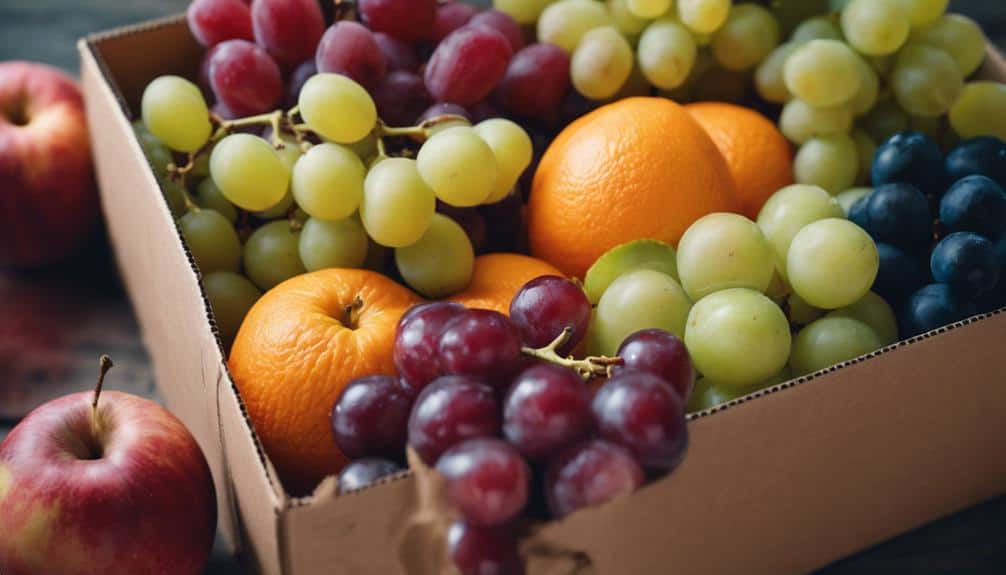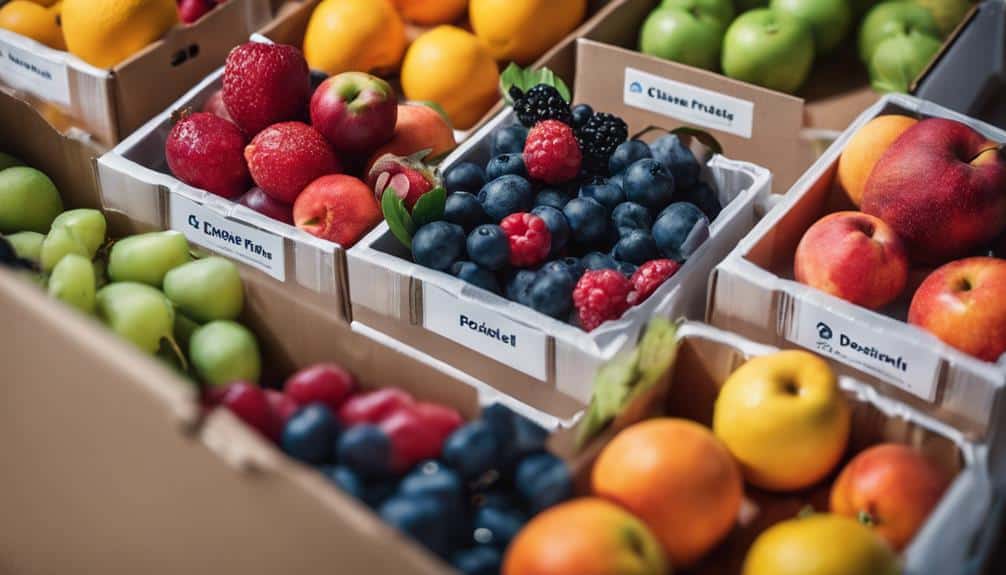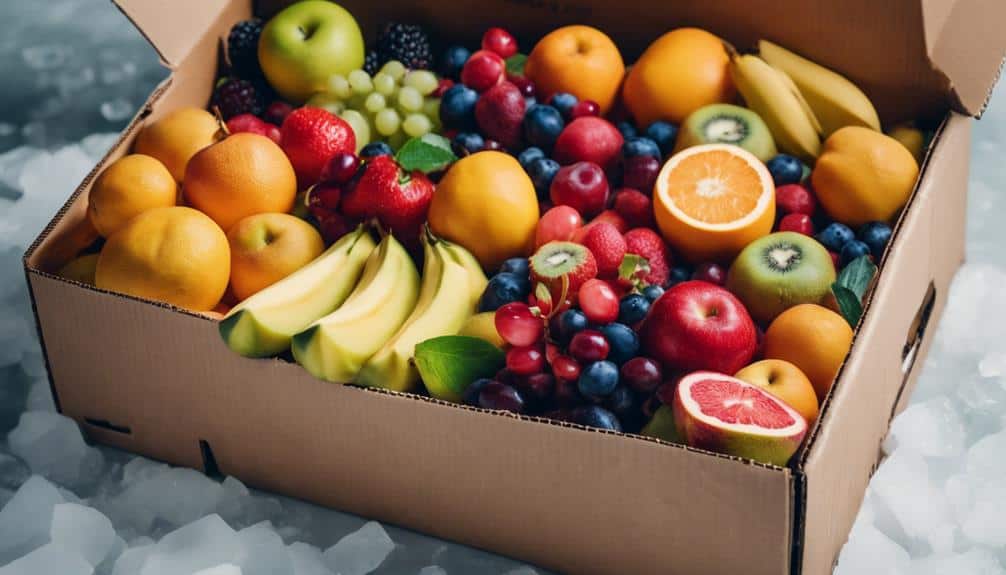To master the art of shipping fresh fruit, adhere to USPS regulations to guarantee compliance and successful delivery. Use sustainable packaging materials and proper insulation like gel packs for temperature control. Individual wrapping of each fruit in protective material prevents damage. Choose expedited services for interstate shipping and research destination countries' import regulations for international shipments. Focus on meticulous packaging and cooling methods to preserve fruit freshness. By following these steps, you can enhance the quality of shipped fruits.
Key Takeaways
- Use sustainable packaging materials to minimize environmental impact.
- Properly insulate fruit with gel packs or dry ice for temperature control.
- Individually wrap fruits to prevent bruising during transit.
- Choose expedited delivery services for freshness upon arrival.
USPS Regulations for Fresh Fruit

When shipping fresh fruit within the United States, it is essential to adhere to the regulations set forth by the United States Postal Service (USPS).
Fruit shipping challenges often arise due to the perishable nature of the produce and the need to maintain freshness during transit.
Seasonal fruit considerations play a vital role in determining which fruits can be shipped. USPS permits certain varieties like oranges, cherries, peaches, pears, and grapefruits.
However, bananas, coconuts, dates, figs, mangoes, and tomatoes are among the prohibited fruits.
To guarantee compliance, all fruits must be free of pests and diseases, and it is advisable to check with the state Department of Agriculture for any additional restrictions that may apply.
Proper Packaging Techniques
To guarantee the safe and fresh delivery of fresh fruit, meticulous attention to proper packaging techniques is essential.
When shipping fresh fruit, sustainable packaging and temperature control are vital aspects to take into account. Here are some key techniques to make certain your fruit arrives in ideal condition:
- Use Sustainable Packaging: Opt for eco-friendly materials like biodegradable or recyclable packaging to reduce environmental impact.
- Maintain Temperature Control: Utilize insulated shipping boxes with gel packs or dry ice to keep the fruit at the appropriate temperature during transit.
- Secure Individual Wrapping: Wrap each fruit separately in protective material like bubble wrap to prevent bruising or damage.
- Make Sure Sturdy Packaging: Pack fruits in a sturdy corrugated cardboard box with proper cushioning to prevent shifting and potential harm during shipping.
Tips for Interstate Shipping

For efficient interstate shipping of fresh fruit, prioritize selecting expedited delivery services to secure ideal freshness upon arrival.
When shipping fruit across state lines, consider using USPS Priority Mail for 1-3 day delivery with flat rate options or opt for Priority Mail Express for overnight service to guarantee perishables reach their destination swiftly.
While FedEx and UPS also offer express shipping, be mindful of potential higher shipping costs.
To maintain freshness during transit, pack fruits securely with cooling elements like gel packs or dry ice in insulated shipping boxes.
Additionally, be strategic with your shipping schedule, aiming to ship early in the week to avoid delays over weekends that could impact fruit storage conditions.
International Shipping Guidelines
International fruit shipping requires thorough understanding of destination countries' import regulations and necessary documentation. When shipping fresh fruit internationally, it is vital to follow specific guidelines to guarantee a smooth process.
Here are key points to reflect on:
- Research customs clearance procedures and requirements.
- Prepare all essential paperwork, including phytosanitary certificates.
- Collaborate with a customs broker for accurate labeling and handling of import duties.
- Securely pack the fruit with appropriate cushioning and cooling elements to maintain freshness during transit.
Essential Fruit Shipping Practices

When preparing fresh fruit for shipping, meticulous attention to packaging and cooling methods is imperative to confirm the fruit arrives at its destination in ideal condition.
Utilizing fruit preservation methods such as individually wrapping each fruit in bubble wrap or tissue paper, placing them in sturdy corrugated cardboard boxes with cushioning material, and including insulated shipping boxes with gel packs for cooling are essential practices.
Consider shipping cost analysis when choosing the appropriate cooling elements like dry ice for extended transit.
Prioritizing these practices guarantees that the fruits remain fresh and undamaged during transportation, ultimately leading to satisfied customers and successful deliveries.
Conclusion
Mastering the art of shipping fresh fruit is not just a skill—it's a necessity for those seeking perfection in delivering nature's bounty.
With meticulous attention to detail, adherence to regulations, and a commitment to preserving quality, senders can become maestros of fruit transportation.
By honing their expertise in packaging, shipping methods, and compliance with international guidelines, they can guarantee that each fruit arrives at its destination as a pristine, delectable delight.

Oliver Postman was born and raised in a small town in the Midwest, where his fascination with postage began at an early age. At just six years old, he stumbled upon a box of old stamps in his grandfather’s attic, igniting a passion that would shape his life.

